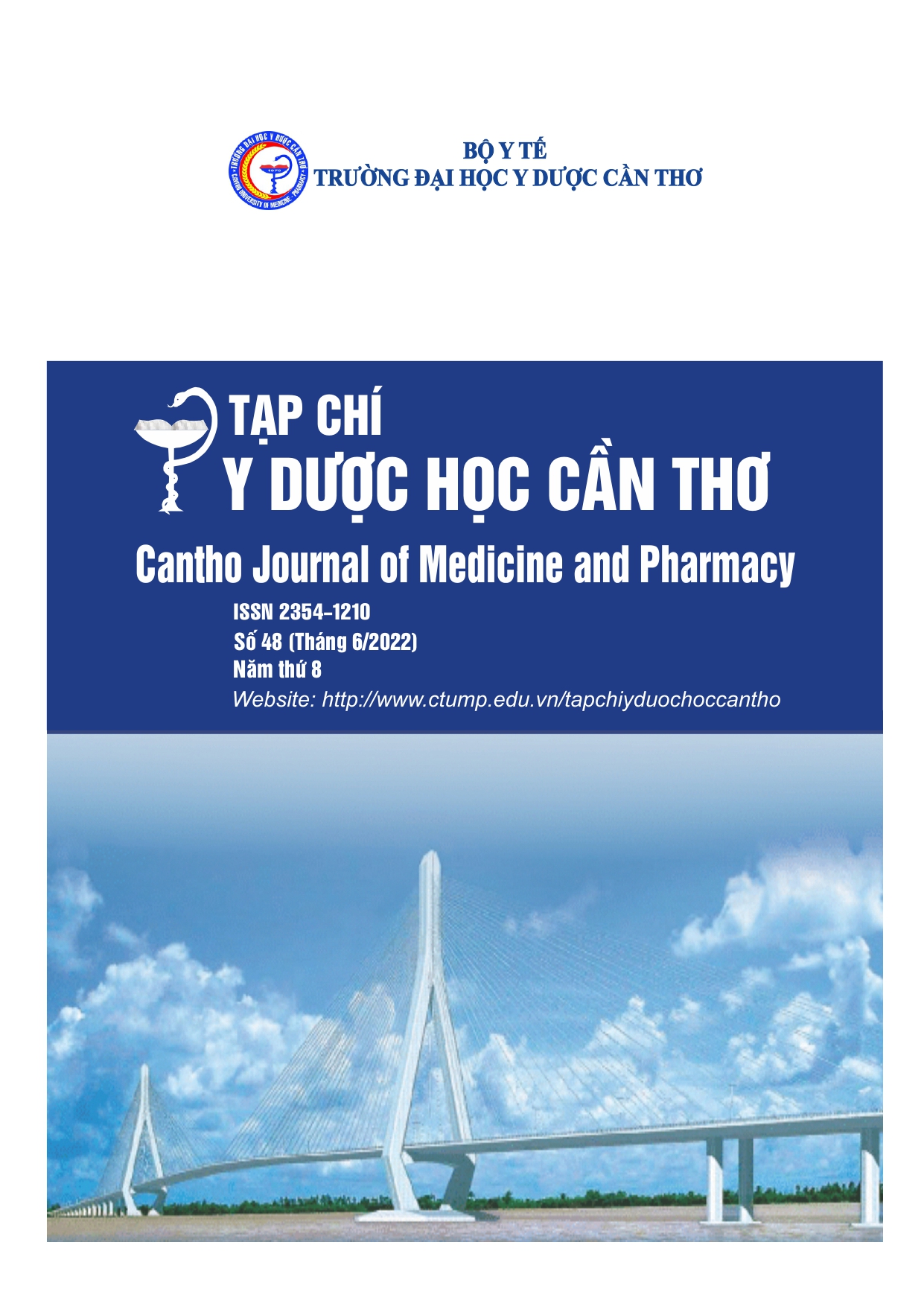KHẢO SÁT ĐẶC ĐIỂM ĐA HÌNH GEN CYP2C19 Ở BỆNH NHÂN NHỒI MÁU CƠ TIM CẤP TẠI BỆNH VIỆN ĐA KHOA HOÀN MỸ CỬU LONG NĂM 2021 - 2022
Main Article Content
Abstract
Background: The CYP2C19 gene polymorphism has a directly affects on the metabolism of clopidogrel, a drug commonly used to prevent acute myocardial infarction. Objectives: To investigate the characteristics of CYP2C19 gene polymorphisms in patients with acute myocardial infarction at Hoan My Cuu Long General Hospital, 2021-2022. Materials and methods: A cross-sectional descriptive study on a total of 86 patients with acute myocardial infarction hospitalized at Hoan My Cuu Long General Hospital. Genotypic polymorphism of CYP2C19 was performed by Real-time PCR. Results: The results showed that a total of 45.3% of patients with acute myocardial infarction carried the CYP2C19 gene polymorphism. There were 4 polymorphisms identified: heterozygous CYP2C19*2 accounted for 32.6%; heterozygous CYP2C19*3 accounted for 4.7%; homozygous CYP2C19*2 accounted for 2.3%; Homozygous CYP2C19*3 accounted for 1.2%; andcompound CYP2C19*2/CYP2C19*3 accounted for 4.7%. The study results showed that up to 37.2% of patients had an intermediate metabolic phenotype; and 8.1% of patients metabolised poorly phenotype with clopidogrel and needed to be replaced with another antiplatelet drug. There was a statistically significant relationship between the ratio of CYP2C19 gene polymorphisms with the cardiovascular risk factor of hypertension (p=0.043) and coronary stent revascularization (p=0.048), nine other risk factors and age characteristics, sex and acute myocardial infarction had not been recorded to have a statistically significant relationship due to p>0.05. Conclusion: A total of 45.3% of patients with acute myocardial infarction hospitalized at Hoan My Cuu Long General Hospital, in 2021-2022 carried the CYP2C19 gene polymorphism and 8.1% of subjects need to be changed to the antiplatelet drug.
Article Details
Keywords
Acute myocardial infarction, gene polymorphism, CYP2C19
References
2. Nguyễn Quỳnh Hoa (2019), “Tình hình đa hình gen CYP2C19 ở bệnh nhân được can thiệp động mạch vành”, Luận văn Thạc sĩ Y học, Trường Đại học Y Hà Nội.
3. Trần Hòa (2020), “Nghiên cứu mối liên quan giữa kiểu gen giảm chức năng CYP2C19*2,*3 và tiên lượng ở bệnh nhân được can thiệp đặt stent động mạch vành có điều trị Clopidogrel”, Luận án Tiến sĩ Y học, Trường Đại học Y Dược TP.Hồ Chí Minh.
4. Hoàng Quốc Hòa, Nguyễn Đỗ Anh (2016), “Khảo sát vai trò của CYP2C19 trên tổn thương mạch vành đích ở bệnh nhân nhồi máu cơ tim sau đặt stent có sử dụng clopidogrel”, Y học TP. Hồ Chí Minh, 20(6), tr.308-316.
5. Nguyễn Thị Mai Ngọc (2018), “Sử dụng xét nghiệm đa hình gen CYP2C19 trong thực hành lâm sàng, Viện tim mạch quốc gia Việt Nam”, Bệnh viện Bạch Mai, Hội nghị tim mạch toàn quốc 2018.
6. Brown S.A, Pereira. N et al. (2018), “Pharmacogenomic Impact of CYP2C19 Variation on Clopidogrel Therapy in Precision Cardiovascular Medicine”, Journal of Personalized Medicine, 8(1), pp.1-31.
7. Myrand. S.P, Sekiguchi. K et al. (2008), “Pharmacokinetics/genotype associations for major cytochrome P450 enzymes in native and first- and third-generation Japanese populations: comparison with Korean, Chinese, and Caucasian populations”, Clinical Pharmacology & Therapeutics, 84(3), pp.347-361.
8. Nishio R, Shinke T et al. (2012), “Effect of cytochrome P450 2C19 polymorphism on target lesion outcome after drug-eluting stent implantation in japanese patients receiving clopidogrel”, Circulation Journal, 76(10), pp.2348-2355.
9. Sorich M.J, Rowland A et al. (2014), “CYP2C19 genotype has a greater effect on adverse cardiovascular outcomes following percutaneous coronary intervention and in Asian populations treated with clopidogrel: a meta-analysis”, Circ Cardiovasc Genet, 7(6), pp.895-902.
10.Tahara N, Shinke T et al. (2018), “Impact of Cytochrome P450 2C19 Reduced-Function Polymorphismon Lesions and Clinical Outcome in Japanese Patients After Drug-eluting Stent Implantation”, Kobe Journal of Medical Sciences, 64(2), pp.E56-E63.
11.William B. Kannel (1995), “Framingham Study Insights into Hypertensive of Cardiovascular Disease”, Hypertension Research, Vol.18(3), pp.181-196.
12.Xie X, Ma Y.T et al. (2013), “CYP2C19 phenotype, stent thrombosis, myocardial infarction, and mortality in patients with coronary stent placement in a Chinese population”, PLoS One, 8(3), pp.e59344.
13.Yamamoto K, Hokimoto S, et al. (2011), “Impact of CYP2C19 polymorphism on residual platelet reactivity in patients with coronary heart disease during antiplatelet therapy”, Journal of Cardiology, 57(2), pp.194-201.
14.Zhixiong Zhong, Hou J, et al. (2018), “Effect of cytochrome P450 2C19 polymorphism on adverse cardiovascular events after drug-eluting stent implantation in a large Hakka population with acute coronary syndrome receiving clopidogrel in southern China”, European Journal of Clinical Pharmacology, 74(4), pp.423-431.
15.Ziwei Xi. Z, Fang. F et al. (2019), “CYP2C19 genotype and adverse cardiovascular outcomes after stent implantation in clopidogrel-treated Asian populations: A and meta-analysis”, Platelets, 30(2), pp.229-240.


